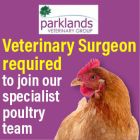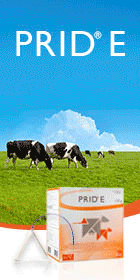UCD Research - October 2022
UCD and LMU Veterinary CSCs share simulation model-making insights
In July 2022, the UCD Clinical Skills Centre (CSC) team, Mark McCorry, CSC Manager, and Tracey Murphy, Senior Laboratory Technician, attended a three-day veterinary simulation model-making workshop in Lincoln Memorial University (LMU) in Kentucky, Tennessee. Mark reports on the experience and the insights it offered on veterinary medicine skills acquisition through simulation
In association with

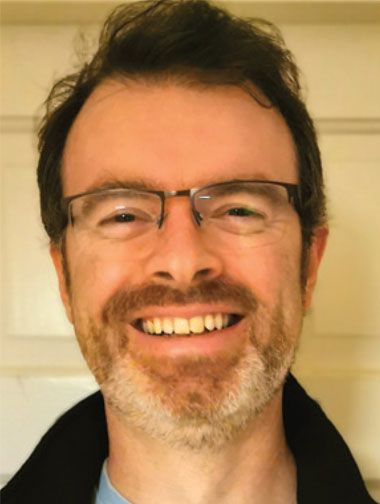
Mark McCorry
CSC Manager
As practical, hands-on training plays an increasingly bigger role in veterinary education, a School of Veterinary Medicine Clinical Skills Centre (CSC) has a vital and demanding part to play in curriculum development, practical teaching and skill improvement and assessment, with a focus on Day One Competencies. The UCD CSC facilitates skills training through the use of simulation models in a dedicated space.
Veterinary clinical skills can be defined as psychomotor tasks that can be assessed in a simulated environment or within the clinical workplace (Read 2022). The goal is that the student will combine the theoretical knowledge, procedural knowledge, diagnostic reasoning and clinical decision-making with the skill. The skill is practised repeatedly so as to be able to modify it when required, thus creating a competent veterinary professional. By using the CSC for practical classes and repeated supervised and self-directed practice sessions, it is hoped that the student will grow and learn from CSC staff feedback. Assessment to ensure competency is important and this can be achieved in a simulated manner through objective structured clinical examinations (OSCEs) or by directly observed practical skills (DOPS) in a clinical setting.
Skills Acquisition Through Simulation
There is a vast array of models available from low to high fidelity (the level of exactness that the model or simulation represents relative to a real-life patient) and a range of costs too. As the Clinical Skills Centre Manager, I believe it is important to achieve a balance to ensure that simulation models with high levels of fidelity are available for the students but also to ensure that the CSC has a sufficient amount of models for students to practice with.
A high cost model may represent incredible high fidelity but the high cost may result in fewer numbers of models being available for users. As a result, these models are either for restricted or for supervised use only. If the model is damaged, it may need to be sent away for repair or the model may have to go out of use. Due to these considerations, it is often up to the Clinical Skills Centre team to develop and create simulation models. We are very fortunate in UCD to have a range of veterinary professionals to help assist with model development. This can often involve exploring the desired learning objectives the model needs to achieve, how the model should react or feel, and how important the fidelity level is.
Overall, our goal is to create an in-house veterinary simulation model that can be used without restriction by the students to help develop and build their psychomotor skills, confidence and competency. Besides producing models, we create a ‘How To’ video and provide written instructions on how to use the model and how to perform the procedure using the model. These resources can be used to support a flipped classroom approach, i.e., helping students prepare prior to practical classes and assisting the students when practicing in a self-directed manner following the practical class.
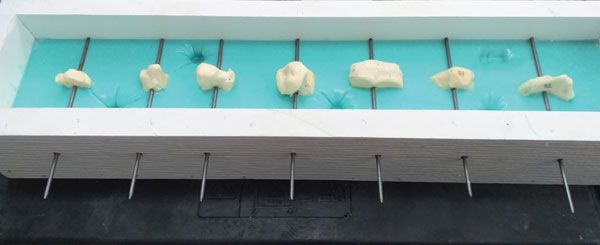
Figure 1
“I’m A VETERINARY NURSE, Not A Model-Maker!”
Developing and creating a model from scratch has many challenges as clinical skills teaching staff have the veterinary training and experience but not necessarily the model-making skills to transfer the skill from live animal to model. The result is a lot of trial and error; lots of errors! However, each error is a step to success.
In July 2022, Tracey Murphy and I received an amazing opportunity to attend a veterinary simulation model-making workshop at Lincoln Memorial University (LMU) College of Veterinary Medicine. William R. Collingsworth, LMU’s Clinical Skills Model Coordinator, hosted a veterinary model-making workshop for 20 invited participants over three days. This was a unique opportunity to:
explore the art of model design and making;
receive an introduction to, and explanation of, the use of a variety of model-making materials; and,
learn how to apply these skills and materials to veterinary procedures and skills.
A tour of the facilities of this newly-built campus was provided. The tour included a visit to a Small Animal Clinical Skills Center with a 200-student capacity and provision of several teaching spaces (surgical skills, medical skills, anaesthesia). The campus has its own Equine and Bovine Teaching Centers with full stocks and crush facilities and a range of models for large animal skills practice.
The workshop was interactive and utilised a range of model-making resources, including the vast range of silicones available and their potential uses, casting options to allow for future replication of model materials, and ballistic gel for ultrasound model simulation, among many other areas of interest.
There was a discussion on model-making and model creation. Practical applications were studied such as the creation of a six-layer skin model to improve the fidelity of surgical skills and the development of a two-dimensional model mould from an original piece. The original piece was a sheep vagina made from clay which was dried, and a mould then made from the clay model. Multiple silicone replications can be made from this mould and this technique provides skills and materials that can be applied to a range of similar applications. During the workshop, an intramuscular injection pad was developed as was the ability to create durable veins to allow for intravenous injection, blood sampling and intravenous catheter placement technique practice.
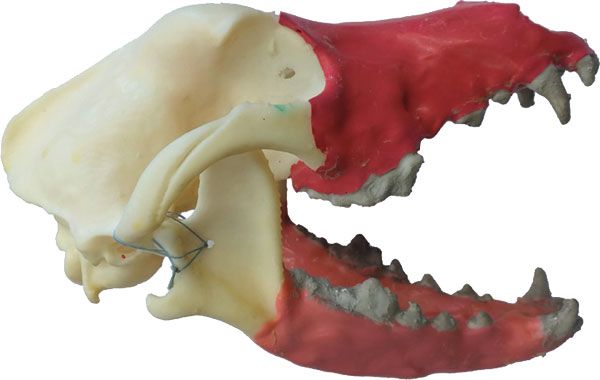
Figure 2.
3-D mould-making
Three-dimensional mould-making was also discussed and practiced. For this, a mould box of sufficient size is created and the moulded items (bones in this case, Figure 1) are suspended using metal rods which are secured halfway up the mould box. The lower half of the box is then poured with a mould-making material and left to set. The upper half is completed the next day.
The group explored and created the best way to produce essential pour and vent holes. This process will allow for replication of these bones from a solid casting material to facilitate realistic representation in future teaching. The three-dimensional mould approach was also applied to testicle creation for neutering models. The testicles can be reproduced easily by pouring pigmented silicone into the completed mould. Brush-on mould techniques were also practised to create higher fidelity dental models (Figure 2) and to replicate a pig ear venous model to practice intravenous blood sampling and injection techniques.
On the final day, an ultrasound simulation model using ballistic gel was created. Placing small objects inside the gel that have to be identified by the persons using the ultrasound probe allows for excellent simulation and assessment of technique. This improves dexterity and identification skills when operating an ultrasound probe.
The open and sharing nature of skills teaching was evident daily as the workshop participants were encouraged to bring along any models they were working on or developing. It was a pleasure to participate every day at the workshop where there was an open and insightful discussion of model development and model-making, skills teaching and student engagement, and skills assessment. Among the many discussions that took place were conversations about the use of foams, slush casting and 3D printing in model creation. Such was the enthusiasm, cooperation and collaboration among the 20 participants that a Facebook group was created to facilitate ongoing discussions and initial plans were made for an annual workshop.
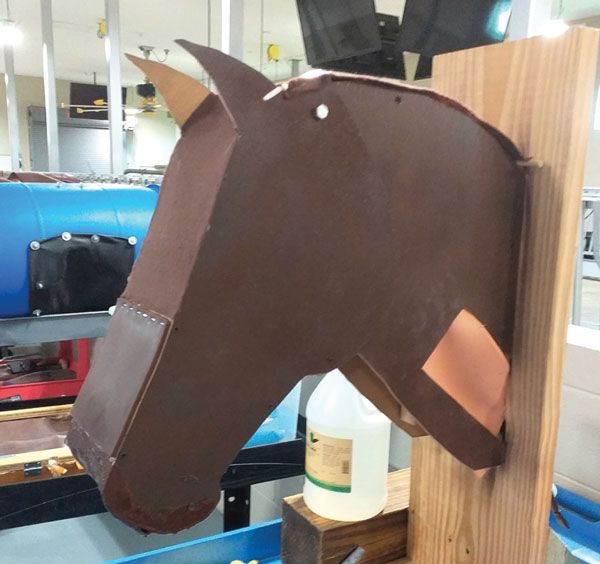
Figure 3.
Every Clinical Skills Centre should have a William “Bill” Collingsworth. Bill allowed all participants access to the extensive models he and his team have created, which include, an equine nasogastric model (Figure 3), several dystocia models, large animal castration models, ophthalmic models, epidural models and much, much more. Workshop participants were allowed to use and explore these models and Bill provided extensive and engaging instructions on their manufacture.
Further information for the reader can be found on the Veterinary Clinical Skills and Simulation website, https://www.clinicalskillsandsimulation.com/ which has open forums and discussions for those developing models. They host a regular ‘show and tell’ online meeting with presentations on skills teaching, assessment and model development. Another useful resource is InVeST (International Veterinary Simulation in Teaching). This is a conference promoting and advancing the use of simulation in veterinary teaching. This event will run in St George’s University in Grenada in February 2023.
Reference
Read, E.K, Read, M.R, Ballie, S. (2022) Veterinary Clinical Skills. Wiley Blackwell
In association with


Mark McCorry
CSC Manager


